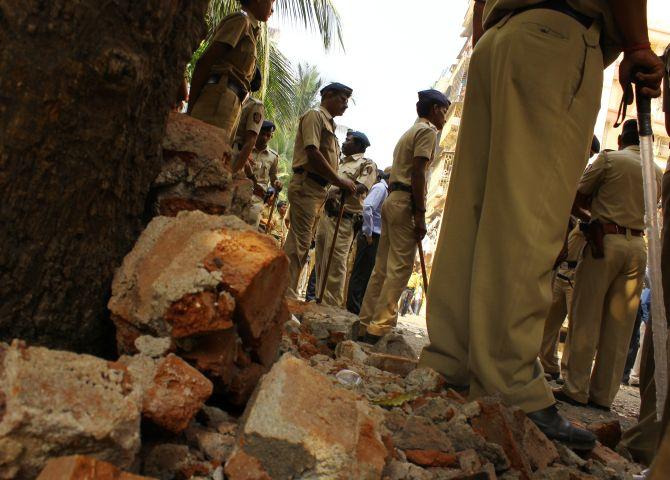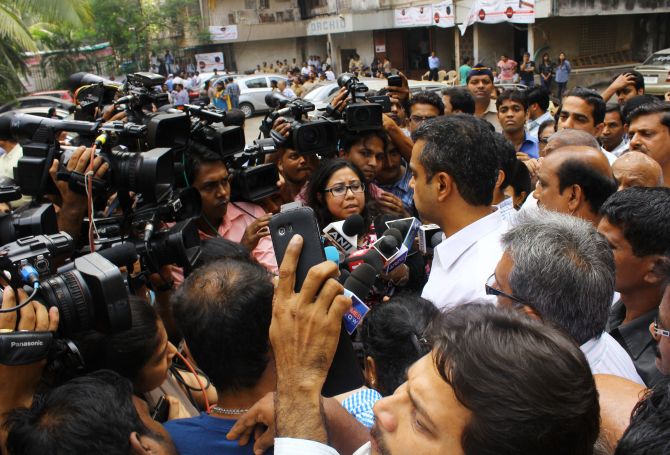 | « Back to article | Print this article |
Breather for Campa Cola residents, but struggle far from over
Over a period of a few hours, the mood swung from desperation and anger to exuberance. But there's a long way to go for residents of the seven buildings in Mumbai's Campa Cola compound. Abhishek Mande Bhot reports
The large gate was conspicuous by its absence. Over two dozen cars that were parked haphazardly along the approach road to block the Brihanmumbai Municipal Corporation officials from entering their apartments were missing too.
It was Day Two of the battle between the BMC and residents of what is being called 'Campa Cola Compound' and on Wednesday morning, it looked like the BMC had scored a victory.
For some years now, residents of the seven buildings in the Campa Cola compound have been lodged in a legal battle with the Corporation over illegal floors.
The battle
The battle began in 2005 when six of the seven societies went to court for a water connection. They were following in on the footsteps of Mid Town, the 20-storey tower that had got the high court to order the BMC to supply them water on humanitarian grounds. (To this day Mid Town remains the only society in the compound to have a BMC water connection. Tankers supply water to the other societies.)
On being questioned, BMC responded that the connections were not given due to FSI violations. So when the high court ordered the municipal body to take action, it issued demolition notices to all floors above the fifth floor.
The violations
A city where real estate costs more than human lives, Mumbai has fairly strange rules regarding construction on a plot of land and occupation of flats.
The real trouble for the residents of Campa Cola compound began a lot before 2005.
In 1955, BMC had leased the land on which the societies now stand to Pure Drinks Ltd to construct a factory of the popular soft drink company, Campa Cola. 25 years later, in 1980, Pure Drinks sought permission from the BMC to develop a portion of the land for residential purposes.
The plot was divided into two (though in the original plan it still remains a single undivided one) and Yusuf Patel, BK Gupta and PSB Construction Company were granted the power of attorney to construct nine buildings of five stories each.
But rather than sticking to the plan, the three builders constructed seven buildings of varying heights -- two of them being towers of 17 and 20 floors respectively.
When they refused to pay heed to the BMC order and stop work, the corporation issued a penalty of about Rs 6.75 lakh which the residents say the builders paid and an additional fine of about Rs 5 lakh which they didn't.
In any case, by 1989 all the buildings were complete and the residents were making do with tanker water.
Click NEXT to read further...
The real estate goldmine
If things weren't already complicated enough Pure Drinks sells a part of the plot where the now defunct factory stands to Krishna Developers. The construction company then goes on to purchase another small plot to the west of the compound and intervenes in the litigation as an intervening party.
Since then, things have headed southward for the residents who claim they had no idea that the floors were illegal.
In a matter of a little over three years, the case has gone from the City Civil Court to the Supreme Court with the residents' case being thrown out at almost all stages.
One of them claimed that the 'lightening speed' with which the case has progressed to the highest court was curious. "Even Kasab's case took longer," she said suggesting that Krishna Developers may have had something to do with it.
At Rs 35,000 per square feet upwards, Worli is one of the most expensive real estate areas in the country.
As of November 11, residents of the 90-odd illegal flats were to vacate their homes. But only a dozen or so had left. The others were sticking to their guns, sure that they would be victorious.
Barring the few minutes that morning when BMC's earthmover came dangerously close to one of the two gates threatening to tear it down, the atmosphere was fairly composed. Food was being passed around, people were chatting and if it wasn't for the heavy police presence outside you wouldn't have thought of the crowd as being afraid of losing their homes.
At lunchtime, the lunch for the BMC officials and police personnel was courtesy the society members.
It was a surreal sight, seeing women sporting LV bags and Ray Ban sunglasses handing out food to the very people who were threatening to bring down their homes.
The day ended with the officials disconnecting power and gas to some of the vacant flats. It was a satisfactory end to a struggle. As a police constable having the puri bhaaji provided by the residents said: "Everyone has won!"
Click NEXT to read further...
Articulate protests make way for crude remarks
On the morning of November 12, that backslapping stopped.
The residents were hoping to receive an ordinance from Maharashtra's Chief Minister Prithviraj Chavan that would regularise the illegal flats. But that didn't arrive.
BMC's bulldozer tore down the gates; there was lathi charge, protestors, including women, were hauled and the residents who possibly have never seen the wrong side of the law were shocked.
There was chaos and as the BMC officials entered one of the meter rooms to disconnect the power supply to the entire building, it became clear to everyone that this was the beginning of the end.
Sunanda Verma, who lives on the 11th floor of Mid Town was most visibly upset. Like many others, she had put her life's savings in the apartment. "I cannot believe the CM has the time to inaugurate a club dedicated to Sachin but doesn't have time to pass an ordinance to save our homes! Everyone in Mumbai should boycott Sachin's game," she said.
Verma was also rather put out on being asked about the legality of the house. "Do you think we would have invested everything we have in this flat if we'd known it was illegal? Would you? I assumed if I'd paid my stamp duty and registered my flat and was paying property tax, it was legal," she said.
By now, the articulate protests of the previous day had made way for some really crude remarks. Residents began sloganeering against the BMC as the hapless officers tried to carry out their duties.
Mahnaz Irani who has been living on the 14th floor of Mid Town was another animated lady. She had all the reasons to be so.
The Iranis had moved into the apartment soon after their son fell out of their old apartment and died. In many ways the flat gave a new lease of life to the family.
"My mother-in-law and I sold off all our jewellery; my husband put everything he had into this house and we moved in. My daughters were born here! We don't have anywhere else to go," Irani, now a widow, said.
Between her two daughters and her, the Iranis have been moving some of their important possessions into garages and relatives' homes.
Shahiza Irani, her daughter, said that they haven't been ordering rations for more than four days because they weren't sure where they'd be.
Like the Iranis, the Middays too invested everything they had in the house and had been preparing for the worst. Iqbal Midday has moved out of his parents' apartment with his wife and children. "They couldn't take the stress anymore. We live in a tiny 150 sq feet house in Dongri. It isn't what I had hoped for my children," he said.
Click NEXT to read further...
'I'm not sure I want to celebrate just yet'
Yet another resident, Ashish Jalan had purchased his apartment in 2001 also claimed he had no idea that the building didn't have an Occupation Certificate. The last few months, he said, have been exceptionally trying on his family. "My mother has lost over five kilos; all she does is keep praying. My father has been ill and my son (who's studying in a boarding school) keeps crying every night over the telephone," he said.
The sense of unease has been uniform. Nandini Mehta, who has been at the forefront of the fight, said the family hasn't taken a vacation for as long as she remembers. "This has taken over our lives completely. I don't even know what my children have been doing. It has been crazy," she says.
Despite the tensions within families, the larger picture has been somewhat comforting. Vidya Srinivas, an oncologist with Mumbai's HindujaHospital said that the whole affair has brought the people together. "(For perhaps the first time) we have all fought as one; this has helped to get our neighbours."
It is a sentiment that Nandini Mehta echoes too. "Of course there were disagreements but on the larger issues, everyone including those who aren't being affected, agreed upon."
Amrita Shinde wasn't one of the affected members -- her flat is on the fifth floor and is legal -- but she has been solidly supporting the protestors. "It shouldn't matter, should it? Everyone is being affected in some form or the other."
The shock however didn't last long. By lunchtime, word was out.
A bench headed by Justice G S Singhvi took suo motu cognisance of media reports and stayed the demolition process up to May 31, 2014.
The crowd that was giving sound bites to every television channel on how they'd lost faith in the country and its judiciary began waving the tricolour.
A few even didn't spare Milind Deora, who has been their most vocal supporter in the government, saying they felt cheated by him.
One of them said: "Congress has done nothing for us. We will vote for BJP now."
None of this however stopped them from crowding around Deora when he arrived to congratulate the residents.
After the initial exuberance though -- there were loud celebrations and fire crackers (that even started a small fire) -- the mood was more guarded.
"We're tired of getting stays," Sunanda Verma said, "We've gone through this twice earlier. I'm not sure I want to celebrate just yet."
Now, the only recourse for the residents is the chief minister's ordinance. They're hoping they'll receive it soon. If not, the drama will start on May 31 all over again.
TOP photo features you missed last week
Click on MORE to see another PHOTO feature...




